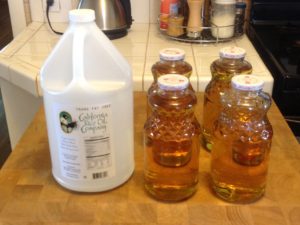By now, you may have heard the news that the Environmental Working Group (EWG) tested 21 oat-based foods and they all tested positive for the Roundup/glyphosate pesticide. The real tragedy of this is that many of these foods are fed to children whose detoxification systems are not yet fully developed so the health effects are much worse for them than adults.
The EPA responded a day later to the EWG’s findings, but they left out some important parts of the story. I wrote what they aren’t telling the public in brackets. Here is their statement:
“EPA has established a tolerance (maximum legal residue level) for residues of glyphosate in oats at 30 parts per million (ppm) or 30,000 parts per billion (ppb). The EWG samples listed in the linked article are all well below the EPA tolerance. Residues of glyphosate on any food or feed item are safe for consumers if they are below the established tolerances. The presence of a detectable pesticide residue does not mean the residue is at an unsafe level.” [Never mind that the EPA has raised the glyphosate tolerance level allowed on oats to now be 300 times higher than it was in 1993.]
“Due to its widespread use, trace amounts of glyphosate residues may be found in various fresh fruits, vegetables, cereals, and other food and beverage commodities. However, these trace amounts are not of concern for the consumer.” [New scientific studies show that even trace amounts of glyphosate can disrupt the endocrine system and gut microbiome, and is strongly linked to fatty liver disease and diabetes, just to name a few.]
“If residues are found above the established tolerance level, the commodity will be subject to seizure by the government.” [But they only test four foods! The USDA and the FDA are the regulatory agencies responsible for monitoring the pesticide residues in our food. The FDA conducts tests for the residues of hundreds of pesticides via its Pesticide Residue Monitoring Program. But prior to 2016, the FDA didn’t test for glyphosate residues (and only then due to enormous public pressure).[1] In the most current report (2016) only corn, soy, milk and eggs were tested. The USDA annually tests hundreds of foods for pesticide residues through their Pesticide Data Program. But as of 2017, they do not test foods for glyphosate residues, a notable omission.[2] That’s why organizations in the private and non-profit sectors are now testing foods for glyphosate residues, to fill in the gap. Here is the link to the FDA’s explanation about why they did not test for glyphosate prior to 2016: https://www.fda.gov/food/pesticides/questions-and-answers-glyphosate]
“EPA has concluded that glyphosate is not likely to be carcinogenic to humans. EPA considered a significantly more extensive and relevant data set than the International Agency on the Research for Cancer (IARC). EPA’s database includes studies submitted to support registration of glyphosate and studies EPA identified in the open literature.” [Most of those additional studies were funded by the chemical companies and were not available to the public. Studies paid for by the agricultural chemical companies are fundamentally biased. The IARC used only publicly available, peer-reviewed studies conducted by independent experts who are free from vested interests.[3]]
“EPA’s cancer classification is consistent with other international expert panels and regulatory authorities, including the Canadian Pest Management Regulatory Agency, Australian Pesticide and Veterinary Medicines Authority, European Food Safety Authority, European Chemicals Agency, German Federal Institute for Occupational Safety and Health, New Zealand Environmental Protection Authority, and the Food Safety Commission of Japan.” [Regulatory agencies are often infiltrated by high level executives who were once employed by the agricultural chemical companies. These executives can then make the rules, such as 1) not monitoring Roundup/glyphosate residues in food and 2) raising the allowable limits. These rules allow the chemical companies to declare that the public is safe from health impacts even in the face of increasing evidence that public’s health is at risk.]
If you doubt the truth of what I am saying here, please read the paper, “Supercide Me”, free and downloadable on our website: https://www.isabelmontclaire.com/books/supercide-me/. My physician, Steven Rotter, MD and I explain the untold part of the Roundup/glyphosate story and include links to credible primary source documents. And I highly suggest you open and scan the links to the FDA and USDA reports included here, to get a general idea of the huge number of pesticides applied to our food. These will make for good reading in the morning while you eat your oat-based breakfast cereal. Just suggestin’.

[1] Monitoring Program, Fiscal Year 2016 Pesticide Report,” US Food and Drug Administration, page 26, accessed at: https://www.fda.gov/media/117088/download
[2] “Pesticide Data Program, Annual Summary, Calendar Year 2017,” Appendix B, page 53, US Department of Agriculture, accessed at https://www.ams.usda.gov/sites/default/files/media/2017PDPAnnualSummary.pdf
[3] https://www.iarc.fr/featured-news/media-centre-iarc-news-glyphosate/










